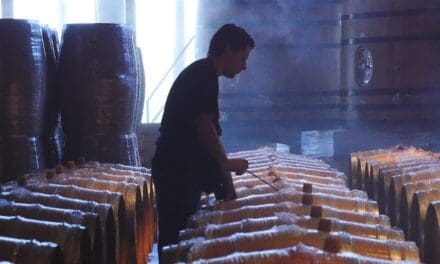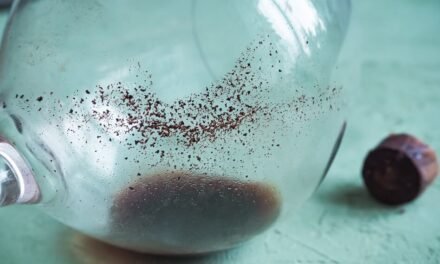Fermentation is a process during which yeast cells consume the sugar in grape juice and convert it into alcohol. As a byproduct, they also produce carbon dioxide and heat. In addition, the wine develops many of its aromas during fermentation.
While it is a natural process, winemakers can manipulate it in various ways. In this article, we will discuss all of these options. But first, let us talk about the fermentation process in more detail.
Why Is Wine Fermentation So Important?
As mentioned, fermentation is responsible for converting sugar into alcohol. So without it, wine would just be sweet, non-alcoholic grape juice. It would also lack all of the nuanced aromas that make wine the great beverage it is.
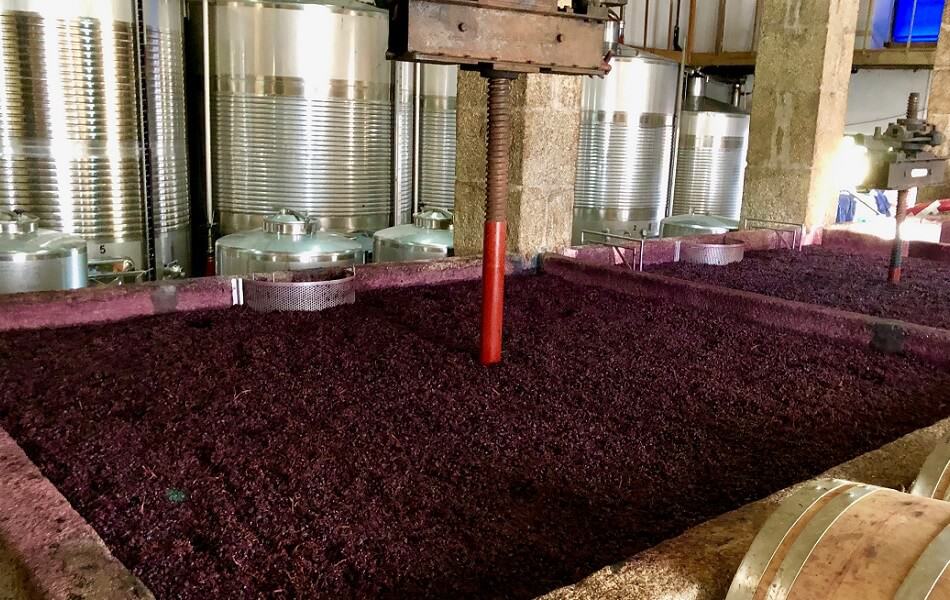
Big Clay Vessel for Wine Fermentation
Two types of fermentation can occur in winemaking: alcoholic fermentation and malolactic fermentation. Alcoholic fermentation is the main type that is a crucial part of winemaking, no matter the resulting wine. On the other hand, malolactic fermentation is only necessary for particular types of wine.
What Is Alcoholic Fermentation?
Alcoholic fermentation is a natural process that occurs when yeast cells transform the sugars in grape juice into alcohol, carbon dioxide, and heat. This process happens shortly after the crushing and pressing of the grapes. For red wines, it typically takes between five and ten days, while white wine fermentation takes one to three weeks.
The yeast responsible for alcoholic fermentation is naturally present on grape skins. But in many cases, winemakers choose to add specific strains of yeast artificially to the juice to have better control of the process. When the process starts, the yeast cells feed on the sugars and begin to multiply rapidly.
The speed and progress of alcoholic fermentation depend on various factors, such as the temperature, the concentration of sugar in the juice, and the type of yeast used.
How Temperature Affects Wine Fermentation
Cooler temperatures help to preserve delicate fruity flavors which are desirable in lighter wines. But they also slow down the fermentation, so fermenting wine at lower temperatures takes more time.
In contrast, higher temperatures support the fast reproduction of yeast cells, resulting in a faster and ultimately shorter fermentation period. The outcome typically is a stronger, full-bodied wine with intense aromas.
How Sugar Concentration Affects Wine Fermentation
Most wines undergo complete alcoholic fermentation, meaning that all the available sugars are consumed. The result is a dry wine with very little residual sugar. However, some winemakers choose to leave some sugar in the wine by stopping fermentation early or adding unfermented grape juice back into the wine. In this case, the resulting wine is off-dry to sweet.
Which Type of Yeast Is Used for Wine Fermentation?
Vintners use various types of yeast for alcoholic fermentation, including natural or wild yeast, as well as cultured or commercial yeast strains. The choice of yeast can have a significant impact on the flavor and aroma of the resulting wine.
Natural or wild yeast are present on the grape skins and in the winery environment. They can be unpredictable, and the fermentation process may take longer and result in more variable flavors compared to using cultured yeast strains. However, some winemakers prefer to use natural yeast as they believe it contributes to the unique character of the wine.
Cultured or commercial yeast strains are selected to ensure a consistent and predictable fermentation. Vintners choose them based on their ability to produce desirable flavors and aromas, such as fruitiness or floral notes, or a specific mouthfeel and texture.
These are the most common yeast types for wine fermentation:
- Saccharomyces cerevisiae is the most commonly used yeast for wine fermentation. It is a robust species that is able to tolerate high alcohol levels and low pH environments. It is known for producing fruity and floral aromas and is commonly used for white and red wines.
- Saccharomyces bayanus is often used in cooler climates where the temperatures are too low for Saccharomyces cerevisiae to ferment properly. It produces less fruity aromas but higher levels of glycerol, resulting in bolder wine with full bodies.
- Hanseniaspora uvarum is used by vintners who want to produce wines with tropical fruit aromas and low levels of acetic acid. It is suited for both white and rosé wines.
- Candida stellata is another type of yeast for making white and rosé wines. It produces high levels of esters, which give the wine fruity and floral aromas.
- Brettanomyces bruxellensis has a rather bad reputation. It is considered a spoilage yeast because it can produce off-flavors and aromas, such as barnyard or horse sweat, in wine. However, in some cases, winemakers intentionally use this yeast to add complexity to the wine.
What Is Malolactic Fermentation?
Malolactic fermentation is a secondary fermentation that occurs after alcoholic fermentation. During malolactic fermentation, malic acid is converted into lactic acid. Malic acid is an intense form of acidity that creates aromas of green fruits. Lactic acid on the other hand creates a buttery, creamy mouthfeel, which vintners desire particularly in complex wines. So the transformation of malic acid into lactic acid contributes to the complexity of the wine and softens its acidic notes.
To perform this transformation, vintners rely on bacteria called Oenococcus oeni. Just like yeast cells, these bacteria are naturally present in the winery environment. But vintners can also add them to the wine artificially.
Usually, malolactic fermentation takes much longer than alcoholic fermentation. Periods of up to several months are common. The precise time depends on the temperature and the pH value of the wine.
Again, not all wines undergo malolactic fermentation. For instance, for light white wines, it does not make sense as it would destroy their delicate flavors. For other wines, malolactic fermentation is an option, though:
- Red wines such as Cabernet Sauvignon, Merlot, Syrah, and Pinot Noir
- Bold white wines, for example, oak-aged Chardonnay
- Sparkling wines like Champagne undergo a second fermentation, too. However, the process differs from table wine fermentation. It is called the “Traditional Method” and happens after bottling the sparkling wine.
Who Discovered Fermentation?
One of the earliest written accounts of intentional wine fermentation comes from the Greek historian Herodotus, who lived in the 5th century BC. He described how the Scythians, a nomadic people who lived in the region that is now Ukraine and Russia, made wine by fermenting grape juice in large animal skins.
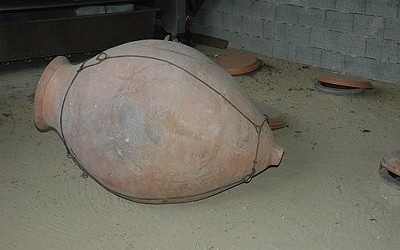
Amphorae for Wine Fermentation from Georgia
Today, wine fermentation is a highly controlled and sophisticated process, and winemakers use a variety of techniques and equipment to create the desired flavor, aroma, and texture in their wines. However, the discovery of wine fermentation remains one of the most important milestones in the history of human civilization, as it led to the creation of one of the world’s oldest and most beloved beverages.
Which Tools and Chemicals Are Used During Fermentation?
Winemakers use a variety of tools and chemicals to assist with the fermentation process. Here are some of the most common ones:
- Winemakers use a variety of vessels for fermentation, including steel tanks, wooden barrels, concrete tanks, or amphorae.
- Monitoring the temperature of the fermenting wine is crucial to ensure that it stays within the optimal range for the yeast to thrive. For this purpose, vintners use various types of thermometers.
- Hydrometers are devices used to measure the specific gravity of the wine during fermentation. This helps winemakers to determine how much sugar has been converted to alcohol, which is important to control the wine’s final sweetness as well as its alcohol volume.
- Yeast is the most important agent in winemaking. The microorganism is responsible for converting grape juice into wine. Winemakers can use commercial yeast strains or rely on wild yeast that is present on grape skins.
- Yeast requires nutrients such as nitrogen and phosphorus to thrive and complete the fermentation process. Thus, vintners may add nutrients to the wine must to make sure the process does not stop prematurely.
- Sulfur Dioxide (chemical symbol: SO2) is a common chemical used in winemaking to prevent oxidation and spoilage. It can also inhibit the growth of unwanted microorganisms.
- Winemakers may add acid, such as tartaric acid, to the must to adjust the pH and ensure the wine is stable. Typically, this happened immediately before or after fermentation.
- Tannins are naturally present in grape skins and seeds. Depending on the desired wine, vintners might add tannins during the fermentation process to improve the wine’s structure and complexity.
It is important to note that not all vintners use chemicals when making wines. Especially if they are committed to organic winemaking, they will refuse to add chemicals artificially.
Which Vessels Are Used for Wine Fermentation?
Wine fermentation can take place in a variety of vessels. As they can significantly impact the flavor, aroma, and texture of the wine, vintners make their choice carefully. The following are the most common vessels for wine fermentation:
- Stainless Steel Tanks are widely used in commercial wineries due to their durability, ease of cleaning, and temperature control capabilities. They are also inert, meaning they do not interact with the wine, which can help to preserve the wine’s natural flavors and aromas.
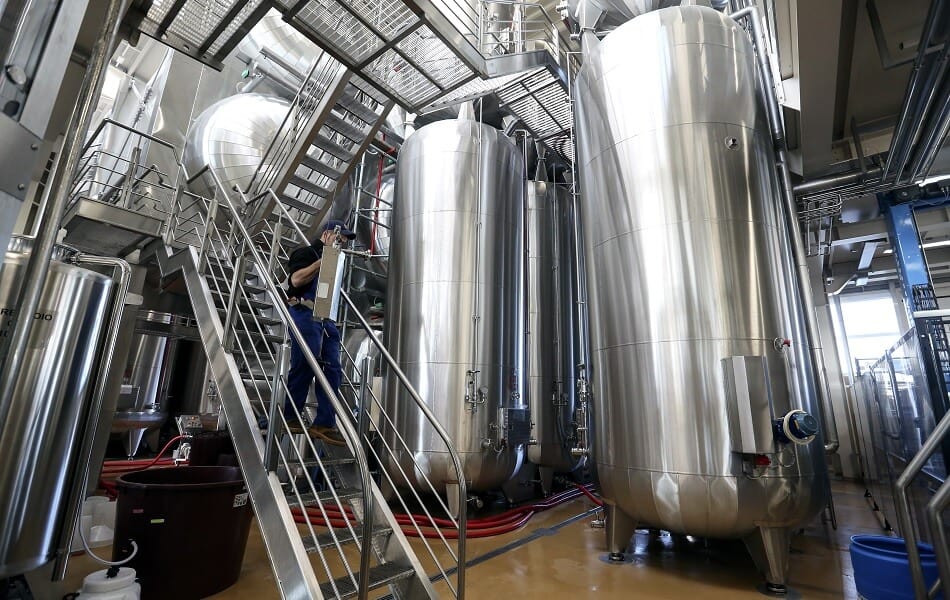
Steel Tanks for Wine Fermentation
- Oak Barrels are often used for the fermentation of high-quality red wines. The oak wood can add flavor and aroma compounds to the wine, as well as contribute to its texture and tannin structure. However, barrels are more expensive than stainless steel tanks and require more labor to maintain.
- Concrete Tanks are a popular choice for natural winemakers, as they are porous and can allow for the exchange of oxygen and carbon dioxide during fermentation. This can help to develop unique flavors and aromas in the wine. Concrete tanks are also durable and do not require the same level of maintenance as oak barrels.
- Amphorae are large, egg-shaped vessels that are made of clay or terracotta. Winemakers have been using them for thousands of years, and they are still popular among natural winemakers. Just like concrete tanks, amphorae are porous, so they allow the exchange of oxygen and carbon dioxide. By doing so, they contribute to the development of unique earthy flavors in the wine.
Ultimately, the choice of vessel for wine fermentation depends on the winemaker’s preferred techniques and the desired characteristics of the resulting wine.
How Can Vintners Manipulate the Fermentation Process?
Winemakers have a variety of techniques at their disposal to manipulate the fermentation process. They use them to achieve their desired flavor profile or to address specific issues that may arise during fermentation. Here are the most common manipulation methods:
- Yeast Selection: As discussed, different strains of yeast have different flavor profiles and fermentation characteristics. Logically, vintners can alter the flavor profile of the resulting wine by choosing a specific strain.
- Nutrient Addition: Yeast requires nutrients such as nitrogen, phosphorus, and vitamins to complete fermentation. If the grape must is deficient in nutrients, it can lead to a stuck fermentation. Winemakers can add nutrient supplements to the grape must to ensure that the yeast has everything it needs to complete fermentation.
- Oxygenation: Besides nutrients, yeast also needs oxygen during the early stages of fermentation to multiply and build up their population. However, too much oxygen later in the fermentation process can cause the wine to oxidize and spoil. Winemakers can manipulate the amount of oxygen that the yeast receives by using different fermentation vessels. Alternatively, they use specific techniques such as punch downs or pump overs.
- Temperature Control: Fermentation is an exothermic process, which means that it generates heat. That might result in various problems: If the temperature gets too high, it can cause the yeast to die or produce off flavors in the wine. Conversely, if the temperature is too low, the fermentation may slow down or stop altogether. Winemakers can manipulate the fermentation temperature by using refrigeration or heating systems to keep the fermentation within the optimal temperature range for the yeast.
- Fortification: Fortified wines are special beverages that are much stronger in alcohol than regular table wines. Typically, they range from 15 to 20%. The reason for this high alcohol content is fortification: Vintners artificially add a strong spirit such as Brandy to the wine before the fermentation naturally ends. The alcohol kills the yeast cells and leaves the wine with a significant amount of residual sugar, making it extremely sweet.
- Extended Maceration: Some winemakers choose to extend the fermentation process although the yeast cells have already died. By leaving the wine in contact with the grape skins for an extended period, it can extract more tannins and flavors. As a result, the wine becomes more complex.
Special Fermentation Techniques
Over the centuries, winemakers have developed numerous methods that deviate from traditional fermentation techniques. Here are some examples:
- Carbonic Maceration: In this technique, whole clusters of grapes are placed in a sealed vessel that is filled with carbon dioxide gas. The grapes ferment from within, without the need for yeast, producing a wine with lower tannins and higher fruitiness.
- Zero Sulfur Fermentation: Sulfur dioxide is commonly used as a preservative in winemaking. But some vintners experiment with zero sulfur fermentation, which involves fermenting and aging the wine without added sulfur dioxide. This can produce a wine with a more natural, unadulterated flavor profile, but also carries more risk of spoilage or oxidation.
- Cryo-Fermentation: In this technique, grapes are frozen before fermentation, which causes the water inside the grape to expand and rupture the cell walls. This releases more juice and flavors into the fermenting must and can produce a wine with higher fruitiness and lower acidity.
These are just a few examples of the many unusual fermentation techniques that winemakers experiment with. While some of these techniques may produce interesting and unique wines, wine laws in many wine regions prohibit most of them. Thus, many vintners are forced to choose: Either experiment with new methods or benefit from the prestige of their home appellations.
Final Words
Fermentation is a crucial process in the production of alcoholic beverages, and wine is no exception. With the information from this article, you now know why. So the next time you open a good bottle, say a toast to the fermentation of grape juice. Cheers!



